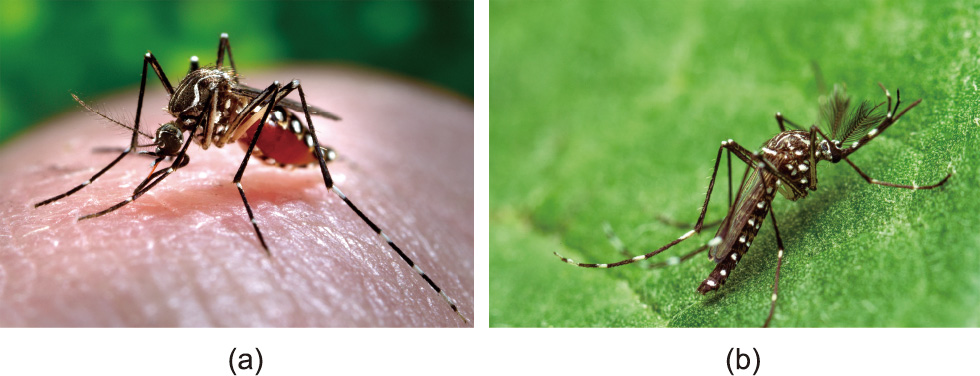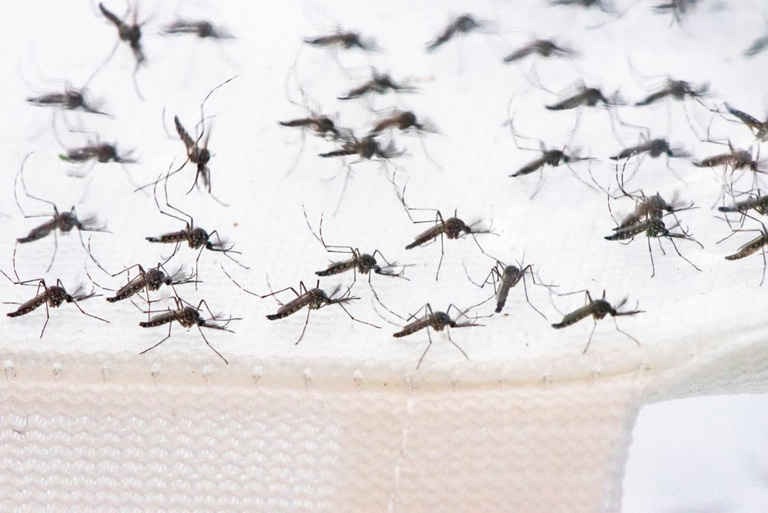In March 2022, the US Environmental Protection Agency (EPA) cleared the Abingdon, UK-based biotech company Oxitec to release up to 2.4 billion genetically modified (GM) mosquitoes through 2024 in California and Florida [1]. The Oxitec mosquitoes—in this case, Aedes aegypti males—are engineered to produce only male offspring and not the female mosquitoes that feed on blood and vector disease (Fig. 1). Releasing large numbers of these GM males aims to reduce the overall mosquito population and thereby the spread of the diseases they can transmit. For Aedes aegypti, this includes the viral illnesses yellow fever, dengue, and Zika; other mosquitoes—in the genus Anopheles—transmit the age-old parasitic protozoan scourge of malaria that remains a front-line public health problem in the developing world, against which GM approaches are also being explored.
《Fig. 1》

Fig. 1. (a) Only female mosquitoes, like this Aedes aegypti female, bite and transmit disease; (b) male mosquitoes, like this Aedes aegypti male, are distinguished from females by their bushier antennae. Credit: US Centers for Disease Control (public domain).
Oxitec’s is just one of many GM-based mosquito control tools currently under development, including ones employing controversial gene drive technology, all of which—like most GM products—face an uphill battle in the court of public opinion. But the Oxitec technology appears closest to reaching broad commercial application. ‘‘I think Oxitec will be successful at suppressing populations in the wild,” said Omar Akbari, professor of cell and developmental biology at the University of California, San Diego, CA, USA, and co-founder of two San Diego, CA-based biotech companies, Agragene and Synvect, that are also developing GM insect technologies. ‘‘They are the first to successfully develop a GM-based technology that can suppress mosquitoes that has been scaled, regulated, and approved.”
Globally, almost 700 million people contract a mosquito-borne illness every year, resulting in millions of deaths, mostly among children aged five and under [2]. Control of mosquito-borne disease has traditionally relied on a relatively expensive mix of preventive measures and treatments, including insecticides, mosquito bed nets, drugs, and vaccinations (including, as of 2021, a vaccine for malaria [3]).
‘‘We have been using insecticides to control mosquitoes for over 100 years, antimalarial drugs for over 200 years, and antimalarial plants for many centuries,” said George Dimopoulos, professor of molecular microbiology and immunology and deputy director of the Malaria Research Institute at Johns Hopkins University in Baltimore, MD, USA. ‘‘Unfortunately, existing strategies have not succeeded in eradicating malaria from the most endemic areas despite a very significant effort.”
Oxitec’s lab-bred male mosquitoes have been engineered to carry an introduced gene that is lethal to their female offspring (Fig. 2). The gene significantly over-produces a protein that interferes with female cells’ ability to produce other essential proteins required for proper development. When the GM males mate with wild females, only their non-biting sons survive. In addition, their male offspring carry the gene and pass it on to half of their progeny. As each successive generation reproduces, more females die. Release enough GM males and the local Aedes aegypti population eventually collapses.
《Fig. 2》

Fig. 2. To test their technology for curbing mosquito-borne disease, UK-based Oxitec plans to release up to 2.4 billion GM adult male mosquitoes in Florida and California. The mass-produced Aedes aegypti, like the release-ready GM males seen here, carry an introduced gene that is lethal to female offspring. Credit: Oxitec (public domain).
Oxitec scientists use the antibiotic tetracycline to temporarily inactivate the female-lethal gene while they breed millions of the insects in a laboratory. Once enough males have been raised, the company can deploy them into the environment. The US EPA has required that the mosquitoes not be released within 500 m of any potential tetracycline sources, including wastewater treatment facilities, commercial fruit growing areas, or commercial livestock producers. To facilitate regular monitoring of the experiment, each GM insect also contains a fluorescent genetic marker that scientists can use to tell them apart from wild ones.
In California, public health officials see the Oxitec approach as a potential means to counter the looming threat of Aedes aegypti mosquitoes and the viral diseases they can transmit. While local transmission of dengue has not yet been reported in the state, Aedes aegypti—an invasive species whose spread is being driven by global warming—was first discovered in California in 2013; by February 2022, it had been found in 22 counties [4].
Florida has a longer history with Aedes aegypti, with small outbreaks of dengue occurring as recently as 2020 [5]. In its pilot study in 2021, Oxitec released nearly five million of its Aedes aegypti GM mosquitoes in the Florida Keys over seven months [6]. The company used more than 22 000 eggs collected from traps near release sites to confirm that all females inheriting the lethal gene died before reaching adulthood. The study also showed that the effect of the releases was transient, with the lethal gene persisting in the wild population through three generations before becoming undetectable [6]. The finding highlights what Akbari cites as one advantage of Oxitec’s approach: ‘‘It is self-limiting,” he said. ‘‘It is not something that will spread like wildfire everywhere and you will never be able to remove it—it is very safe in that regard.”
The goal of the Florida pilot extension, a series of releases between May and July 2022, is to further demonstrate the effectiveness of the company’s technology in controlling wild Aedes aegypti populations. The study will not determine whether the approach reduces the number of viral infections transmitted by Aedes aegypti. Not enough such disease currently occurs in the Florida Keys to make that assessment; a clinical study to show that would need to be conducted elsewhere and it would be prohibitively expensive [7]. Oxitec has not yet announced specific goals for the California trial, which still awaits the state’s approval to proceed.
The company’s 2010 field trials in places with high incident rates of dengue, in Malaysia and the Cayman Islands, showed significant decreases in wild Aedes aegypti populations [8]. Company researchers also reported 95% suppression of Aedes aegypti in a 2015 test in Brazil [9], where the company began selling a version of its product to the public in 2021 (Fig. 3) [10]. For a monthly subscription fee of 10–30 USD [11], residents of the Brazilian state of São Paolo can have a box of Oxitec’s GM Aedes aegypti mosquitoes delivered to their homes. Adding water to the box induces the eggs they contain to hatch, which then grow into male mosquitoes, all of which carry the female-lethal gene.
《Fig. 3》

Fig. 3. Oxitec’s ‘‘Just Add Water” mosquito boxes became available for delivery to customers’ doorsteps in the Brazilian state of São Paulo in 2021 through a 10–30 USD monthly subscription service. When customers fill the boxes with water, the eggs they contain hatch, growing into the male Aedes aegypti mosquitoes with the female-lethal gene. Credit: Oxitec (public domain).
In the agricultural arena where it may face lower barriers and the promise of perhaps greater commercial success, Oxitec applies the same basic female-lethal technology—including the tetracycline control switch and fluorescent gene marker—to produce GM male insects for releases aimed at reducing the devastating impacts of important crop pests, including the fall armyworm (corn) and the diamondback moth (cabbage, cauliflower, and broccoli). Initial pilot studies with GM insects of these species—fall armyworm in Brazil in 2021 [12] and diamondback moth in the United States in 2017 [13]—demonstrated successful reduction of pest numbers. According to the company’s website, Oxitec is also developing GM versions of the soybean looper (soybeans), the medfly (250 kinds of fruits, nuts, and vegetables), and the cattle tick (several livestock species).
While Dimopoulos agreed with Akbari that the Oxitec technology is effective and safe, he said the primary drawback of its population suppression approach is the cost of continuously massrearing and releasing the insects. ‘‘That is why it has mostly been applied in countries that can afford it,” he said. ‘‘And it is not sustainable in the long-term because once you stop releasing the mosquitoes, the area is soon repopulated by the same species.”
In contrast, the GM insect replacement strategy, which involves supplanting disease-carrying insects with GM versions incapable of transmitting disease, may prove more effective but is likely less commercially viable, said Dimopoulos: ‘‘It is harder to make the replacement strategy profitable because once you deploy it, the problem could be solved for years.”
So-called gene drive technology provides the basis for most of the replacement strategies for pest control currently under development. The strategy relies on the genetic cut-and-paste tool clustered regularly interspaced short palindromic repeats (CRISPR) [14] to alter, delete, or add a specific gene, and place the CRISPR mechanism, on a specific chromosome. In subsequent generations, the ‘‘drive” replicates the introduced gene it carries on its partner chromosome so that each gamete contains a chromosome pair with matching introduced genes, thereby passing—or driving— the desired genetic change to a disproportionately high percentage of the offspring in a population. In practice, however, the gene drive approach remains largely theoretical, primarily due to concerns about the potential for negative impacts associated with introducing irreversible and uncontrollable genetic changes to wild populations.
Examples of modified genes that scientists have developed to work in gene drives include one that alters mosquitoes’ microbiota to suppress malaria-causing parasites [15] and another that makes females more male-like—incapable of laying eggs and with mouthparts less able to bite and transmit disease [16]. Scientists are also exploring CRISPR-modified genes in gene drives to manage populations of agricultural pests [17].
Over successive generations, modifications pushed into a population via a gene drive should lead to a progressive reduction in disease-carrying mosquitoes until too few remain to sustain transmission of the disease. ‘‘If you can get gene drive to work in the field, you would only have to release a relatively small number of mosquitoes, significantly lowering the cost compared to what Oxitec is doing,” said Dimopoulos.
Because of its perceived risk for unintended consequences, studies of gene drive technology have been limited to controlled laboratory settings. ‘‘Our goal is reducing the harm caused to humanity by these vectors,” said John Connolly, senior regulatory science officer at Target Malaria, a Gates Foundation-backed, non-profit organization that is developing gene drive-based technologies to combat malaria. ‘‘We are trying to assess potential harms and experimentally measure their probability in the laboratory. We want to be as sure as possible before we would even approach regulators for permission for a release that there would not be any plausible risk to human health or the environment.”
Much more headway has been made with a replacement strategy involving breeding mosquitoes for release that are infected by Wolbachia, a bacterial symbiont commonly found in insects. Some 60% of insect species harbor Wolbachia [18], but it is not naturally found in Aedes aegypti [18]. And while infecting Aedes aegypti with Wolbachia does not appear to harm them, it turns out that Wolbachia blocks viral replication in mosquitoes, thereby greatly reducing the risk that a Wolbachia-infected mosquito will transmit viruses like dengue to the people it bites [18].
Once infected with Wolbachia, mosquitoes pass the symbiont to their offspring, so a one-time release conducted over several weeks can establish virus-resistant swarms. The approach has been applied successfully in numerous locations, including Australia and Brazil[19], with a large trial in 2021 in Indonesia demonstrating a 77% reduction in dengue transmission [20]. Guangzhou Wolbaki Biotech (Guangzhou, China) now releases 50 million Wolbachia-infected Aedes albopictus mosquitoes, also genetically engineered to be non-biting males, on a weekly basis, with the goal of curbing the incidence of dengue infections in and around the city [21].
Beyond the technical challenges, companies developing GM insects face substantial public scrutiny. Ahead of Oxitec’s initial pilot study in Florida, 170 000 people signed a petition opposing the field trial, citing a litany of concerns, including that the company’s GM mosquito could pass its female-lethal gene to people [22]. Oxitec’s GM mosquito program has also been criticized over worries that its deployment could paradoxically further spread dengue, though such concerns have been shown to be unfounded [23].
‘‘I understand the hesitance,” Akbari said. ‘‘People do not want to be guinea pigs. And dengue transmission is rare in Florida, so people question the need for it.” General fears about genetically modified organisms are also a problem and need to be considered, he said. While Dimopoulos is similarly sympathetic, he said he thinks the public’s concerns are somewhat misguided. ‘‘Everything new is sort of scary, and people get concerned about it,” he said. ‘‘At the same time, if you spray insecticides no one cares because we are familiar with them and can buy them at the local store, even though we know how toxic they can be to humans and animals.”
Dimopoulos said one way to mitigate public fear is to educate people and involve them in the deployment of the strategy. He points to Brazil where the World Mosquito Program, a Wolbachia-based mosquito control initiative driven by a group of non-profit companies owned by the Melbourne, Australia-based Monash University, successfully used this tack, airing television commercials about GM insect technology and paying community members to help release Wolbachia-infected Aedes aegypti.
Despite the public pushback, and the technical limitations of current GM-based approaches for controlling insect pests, including the potential development of resistance by the insects or infectious agents to genetic modifications against them, Akbari said many could eventually succeed: ‘‘The need is so big that no one company can capture it all. Each insect is its own market. There are separate markets for different crop pests, for example, each of which lives in a different environment and causes different problems.”













 京公网安备 11010502051620号
京公网安备 11010502051620号




